
Are you tired of rummaging through cluttered shelves to find that one ingredient you need? You’re not alone! A staggering number of homeowners struggle with disorganized kitchens, leading to wasted time and increased stress.
A well-designed pantry organization system can be a game-changer. By maximizing your kitchen’s storage space, you can enjoy a more efficient cooking experience and reduce food waste.
Imagine having a kitchen where everything has its place, and you can easily access the ingredients you need. With the right pantry optimizer system, this vision can become a reality.
Key Takeaways
- Maximize your kitchen’s storage potential with a customized pantry organization system.
- Reduce food waste and save time by having easy access to ingredients.
- Create a more efficient cooking experience with a well-designed pantry.
- Transform your kitchen into a functional and visually appealing space.
- Discover expert tips and strategies for optimizing your pantry.
The Chaos of Kitchen Clutter
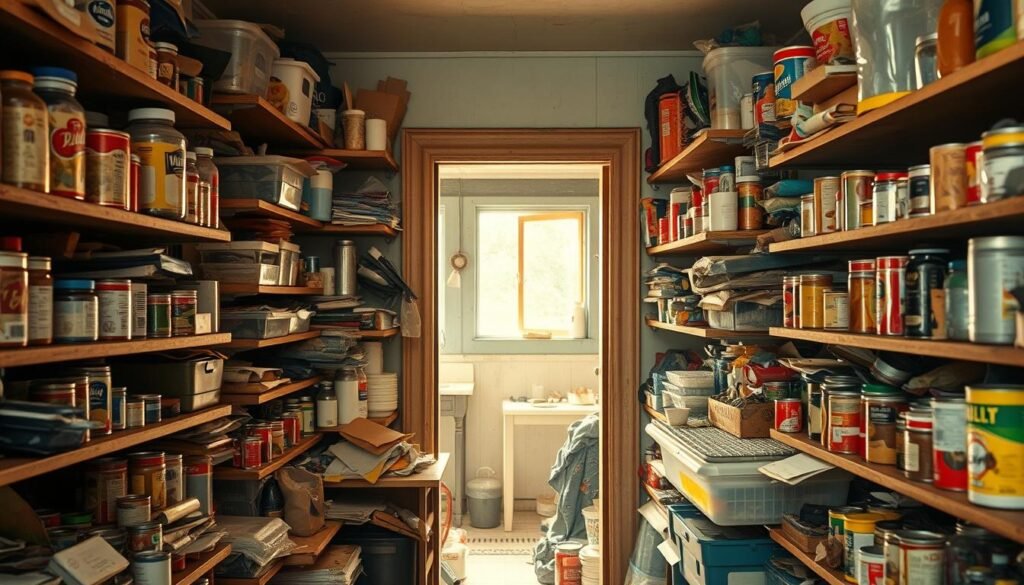
Cluttered kitchens are not just aesthetically unpleasing; they can also have a tangible impact on your daily routine. When your kitchen is disorganized, simple tasks like cooking become frustrating experiences.
A well-organized pantry is crucial for efficient meal preparation and minimizing food waste. However, many of us struggle with common pantry pain points.
Common Pantry Pain Points
Many homeowners face issues with storage in their pantries, leading to clutter and disorganization. This can result in wasted time searching for ingredients and increased food waste due to expired or forgotten items.
The Hidden Costs of Disorganization
The consequences of a disorganized pantry extend beyond mere inconvenience. They include unnecessary expenses from duplicate purchases and impulse buys, not to mention the environmental impact of wasted food.
What Is a Pantry Optimizer System?
A pantry optimizer system is more than just a storage solution; it’s a game-changer for your kitchen. It’s designed to maximize your pantry’s potential, making it easier to find what you need when you need it. By optimizing your pantry space, you can reduce clutter, save time, and even cut down on food waste.

Types of Pantry Optimizer Solutions
Pantry optimizer systems come in various forms to suit different needs and spaces. From adjustable shelving units to pull-out drawers and baskets, there’s a solution for every pantry configuration. Adjustable shelving is particularly useful as it allows you to customize the space according to the size of your storage needs.
Key Features to Look For
When selecting a pantry optimizer system, there are several key features to consider. These include adjustable shelving to accommodate items of various heights, clear containers for visibility, and pull-out or sliding mechanisms to ensure easy access to all areas of your pantry space. Additionally, durable materials and labeling systems can enhance the functionality and maintain the organization of your pantry.
- Adjustable shelving is essential for accommodating items of various heights and allowing your system to evolve as your needs change.
- Clear containers not only create visual harmony but also allow you to quickly assess inventory levels at a glance.
- Pull-out or sliding mechanisms ensure that no item gets lost at the back of deep shelves or in corners.
- Durable materials that can withstand daily use are worth the investment – look for solid construction that won’t sag or warp over time.
- Labeling systems help maintain organization and make it easier for everyone in the household to find items and return them to their proper place.
Benefits of an Organized Pantry
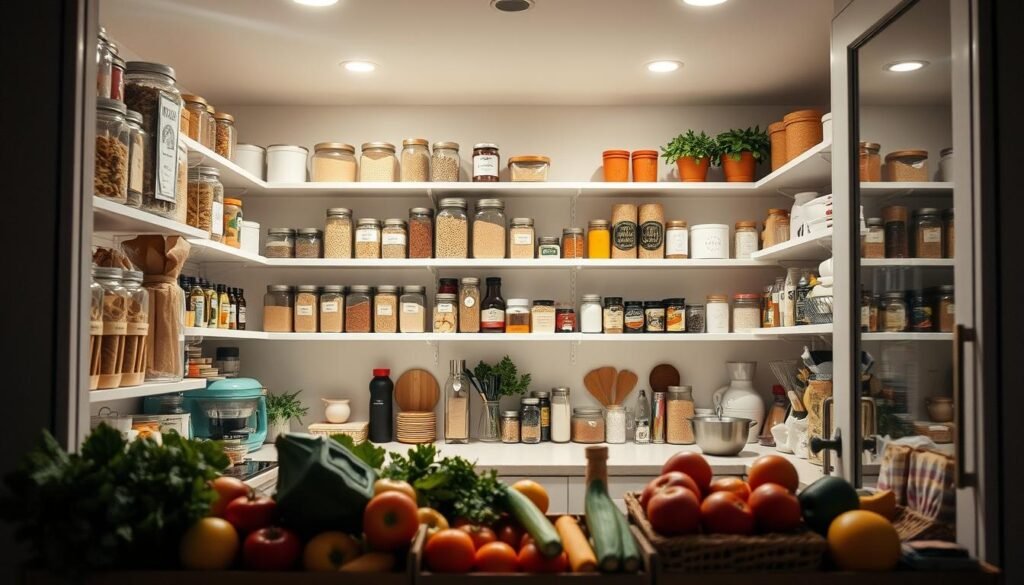
A well-organized pantry is the unsung hero of kitchen efficiency, offering numerous benefits that can simplify your life. By optimizing your pantry space, you can enjoy a more streamlined cooking process, reduce stress, and even save money.
Time and Money Savings
An organized pantry saves you time by allowing you to quickly locate the ingredients you need. This efficiency can lead to significant cost savings over time. With a clear view of your pantry’s contents, you’re less likely to duplicate purchases or waste money on expired or spoiled food.
Reduced Food Waste
Proper storage and organization can significantly reduce food waste. Here are some key strategies:
- Implement a “first in, first out” system to ensure older items are used before they expire.
- Use containers that are airtight and clearly labeled to keep food fresh.
- Keep your pantry tidy and regularly clean out expired or spoiled items.
To illustrate the potential savings, consider the following table that highlights the average annual food waste in different household sizes:
| Household Size | Average Annual Food Waste (lbs) | Potential Savings with Organization |
|---|---|---|
| 1-2 people | 100-200 lbs | $50-$100 |
| 3-4 people | 200-400 lbs | $100-$200 |
| 5 or more people | 400-600 lbs | $200-$300 |
By organizing your pantry and implementing these strategies, you can make a significant impact on reducing waste and saving money. It’s a simple yet effective way to improve your kitchen’s efficiency and your overall quality of life.
Assessing Your Current Pantry Space
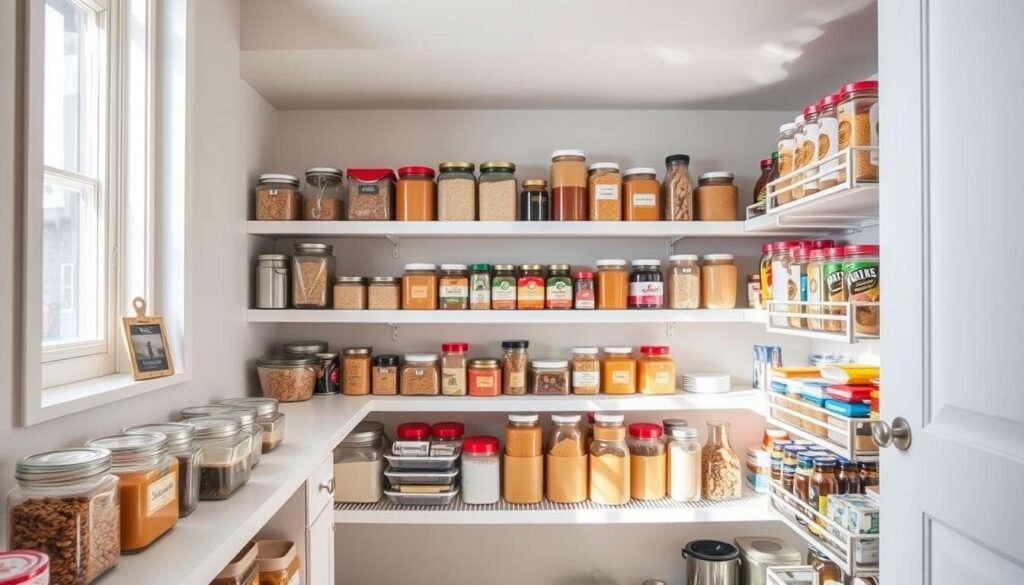
Before you can transform your pantry, you need to understand its current state. This involves taking a closer look at the layout and identifying areas that need improvement.
Measuring Your Space
Start by measuring your pantry’s dimensions, including the width, height, and depth of the shelves. This will help you understand the storage space available and plan accordingly.
Identifying Problem Areas
As you assess your pantry, look for common problem areas such as:
- Deep corners where items tend to get lost
- Overly high shelves that are difficult to access
- Wasted vertical space between shelves
- Categories of items that don’t have a logical home
- Areas that consistently become cluttered
By identifying these issues, you can start thinking about how to optimize your pantry’s layout and make the most of your storage spaces.
Planning Your Pantry Optimization Project
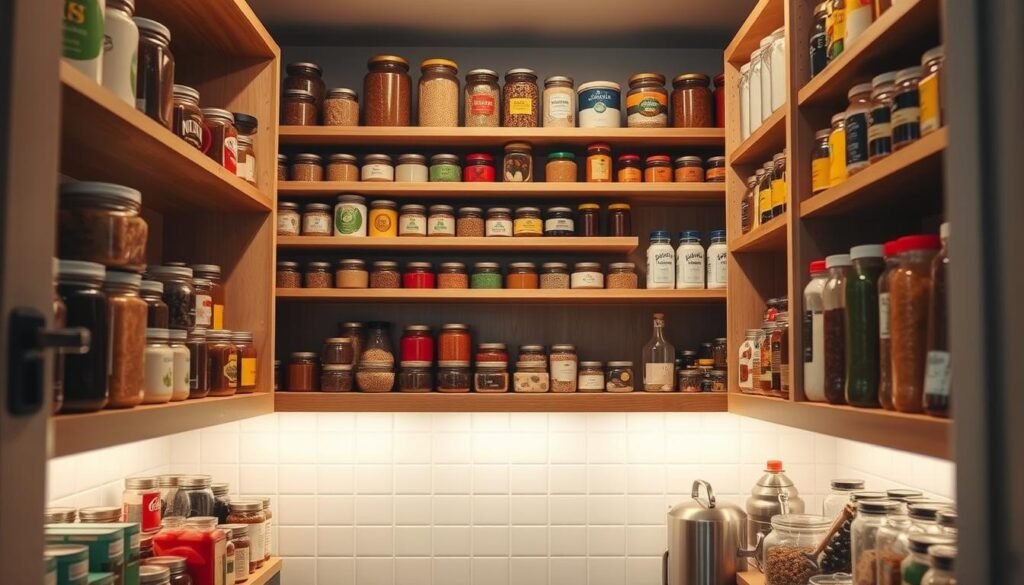
The key to a successful pantry optimization project lies in thorough planning and preparation. By implementing these innovative pantry storage solutions into your organizing routine, you can transform your pantry into an organized and functional space that contributes to a stress-free cooking experience.
To start, you need to define your objectives. What do you want to achieve with your pantry optimization project? Are you looking to increase your storage capacity or make your existing space more efficient? Setting clear goals will help guide your decisions throughout the project.
Setting Realistic Goals
When setting your goals, consider what you want to achieve. Do you want to free up more space in your kitchen or make meal prep easier? Make sure your goals are realistic and achievable. For instance, you might aim to organize your pantry in a way that allows you to see everything at a glance, making it easier to find what you need.
Creating a Timeline and Budget
Once you have your goals in place, it’s time to create a timeline and budget for your project. Determine whether your pantry optimization will be a weekend project or a phased approach over several weeks. Research prices for containers, shelving, and other organization tools to avoid sticker shock and plan accordingly.
| Task | Timeline | Budget |
|---|---|---|
| Assess pantry space | 1 day | $0 |
| Purchase storage containers | 1 week | $100 |
| Install shelving | 2 days | $200 |
By creating a realistic timeline and budget, you’ll be better equipped to handle any unexpected challenges that arise during your pantry optimization project. Remember to prioritize quality storage solutions for frequently used items.
Clearing Out and Decluttering

Are you tired of rummaging through a cluttered pantry in search of a specific ingredient? Clearing out your pantry is the first step towards a more organized kitchen. By taking the time to declutter on a consistent basis, you can eliminate expired items, consolidate duplicates, and ensure that everything in your pantry serves a purpose.
To start, let’s look at some effective strategies for decluttering your pantry.
The FIFO Principle
The FIFO principle, or First In, First Out, is a simple yet effective way to manage your food storage. It ensures that older items are consumed before they expire, reducing waste. By implementing this principle, you’ll be able to keep track of the date you purchased each item and make sure they’re used in a timely manner.
Disposing of Expired Items
When decluttering your pantry, it’s essential to be ruthless with expired items. Check the date on each product and discard anything that’s past its prime. Consider composting expired food items to reduce waste. This process will help you identify purchasing patterns that lead to waste, allowing you to adjust your shopping habits accordingly.
By following these steps, you’ll be able to maintain a clutter-free pantry and make the most of your kitchen space.
Designing Your Pantry Layout for Optimal Flow
To maximize your pantry’s potential, it’s essential to create a layout that promotes flow. A well-organized pantry can streamline your cooking process, making meal prep a breeze. You can organize your pantry seasonally or thematically, depending on what you use frequently.
Maximizing Vertical Space
Making the most of your pantry’s vertical space is crucial. By installing shelves or storage units that go up to the ceiling, you can store less frequently used items, keeping them out of the way but still accessible. This helps maintain a clutter-free environment.
Creating Zones Based on Usage
Zoning your pantry based on how and when items are used creates intuitive organization. Consider creating dedicated zones for breakfast items, baking supplies, dinner ingredients, and snacks. Place everyday essentials at eye level, less frequently used items higher up, and heavy items on lower shelves.
By implementing these strategies, you can create a pantry layout that enhances your cooking experience. Keep similar items together to streamline both cooking and restocking processes. You can also create special zones for dietary-specific foods if household members have different needs.
Essential Pantry Optimizer Tools and Solutions
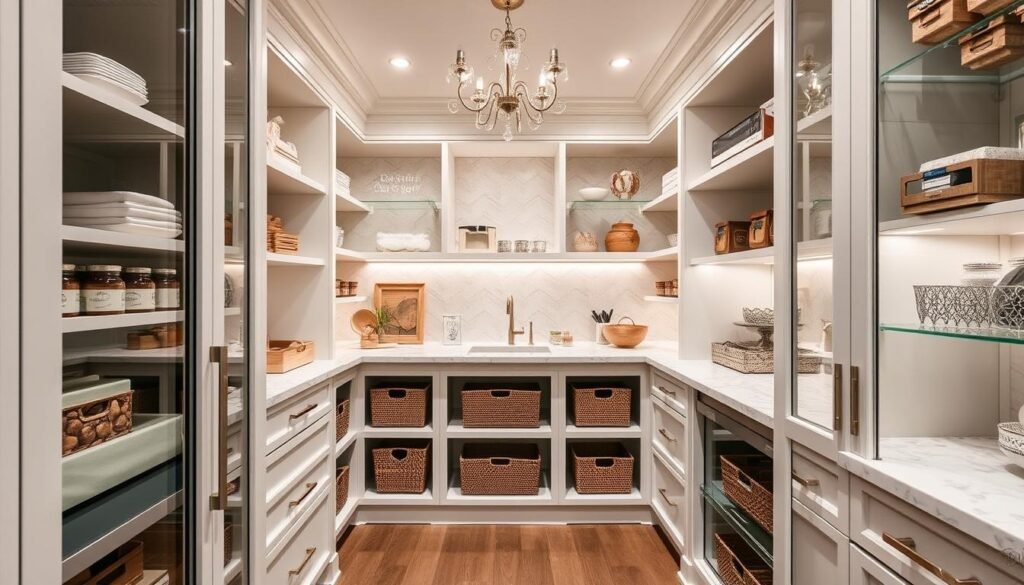
Optimizing your pantry requires a combination of the right storage solutions and organizational tools. There are several innovative pantry storage solutions available in the market. One such solution is the use of stackable containers. These containers allow you to utilize vertical space effectively, making it easier to see and access your pantry items.
With stackable containers, you can say goodbye to rummaging through piles of boxes and bags. Another popular pantry storage solution is pull-out shelves. These shelves are designed to make the most of deep pantry cabinets or closets. With their sliding mechanism, you can easily access items at the back without having to pull everything out.
The right tools can make or break your pantry organization system – investing in quality solutions pays dividends in functionality and longevity. Modern pantry optimizer tools combine aesthetic appeal with practical features that solve common storage challenges. From simple shelf dividers to sophisticated pull-out systems, there’s a solution for every budget and pantry configuration.
Effective pantry organization often involves using drawers and other storage solutions to address various categories of items. By combining different types of storage solutions, you can create a highly functional pantry that meets your needs.
FAQ
How do I maximize storage space in my kitchen?
To maximize storage space, consider using vertical shelving and adjustable baskets to make the most of your cabinet and wall space. You can also utilize the back of a door with over-the-door storage racks or hooks.
What are the best containers for storing food and spices?
The best containers are those that are airtight, clearly labeled, and easy to access. Consider using glass jars or containers with lids to store dry goods, and baskets or bins for grouping similar items together.
How often should I declutter my kitchen storage?
It’s a good idea to declutter your kitchen storage every 3-6 months to get rid of expired or unused items. This will help maintain a clutter-free space and ensure that your storage solutions remain effective.
What are some tips for organizing my kitchen drawers?
To organize your kitchen drawers, start by purging any unnecessary items. Then, use dividers or inserts to separate items into categories, such as utensils, cooking tools, or spices.
How can I make the most of my kitchen’s corner space?
Corner spaces can be tricky, but there are several solutions. Consider using a carousel or lazy Susan to make the most of the space, or install a corner shelf to store infrequently used items.
What are some common mistakes to avoid when organizing kitchen storage?
Common mistakes include overcrowding storage spaces, not labeling containers, and not considering the workflow in your kitchen. Avoid these mistakes by planning your storage solutions carefully and being mindful of your kitchen’s workflow.
